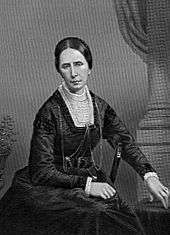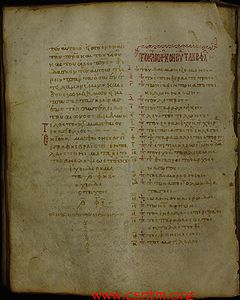Minuscule 543
Minuscule 543 in the Gregory-Aland numbering (ε 257 in Soden's numbering and labelled 556 by Scrivener)[1][2] is a Greek minuscule manuscript of the New Testament, on parchment. Palaeographically it has been assigned to the 12th century.[3]
| New Testament manuscript | |
 The first page of the Gospel of Mark | |
| Text | Gospels † |
|---|---|
| Date | 12th century |
| Script | Greek |
| Now at | University of Michigan |
| Size | 28 cm by 23 cm |
| Type | Caesarean text-type |
| Category | III |
| Hand | minute |
| Note | member of f13 |
The manuscript contains text of the four Gospels with unusual grammar forms and numerous errors. Textually it does not belong to any of the main text-types, and is a member of the textual family Family 13, known also as Ferrar Group. The lacunose manuscript is housed at the University of Michigan.[3]
Description
Contents
The codex contains the text of the four Gospels, on 184 thick parchment leaves (size 28 cm by 23 cm), with several lacunae (Matthew 12:11-13:10; Mark 8:4-28; Luke 15:20-16:9; John 2:22-4:6; 4:52-5:43; 11:21-47). One leaf was misplaced in binding. The parchment is coarse and yellowed by age.[4]
The text of the codex was written two columns per page, 27-30 lines per page,[3] 17 letters per line,[5] in minute hand, in brown ink.[6] The same scribe wrote all four Gospels.[5] There are breathings and accents used in regular form, but in some sort of system. There is not found iota subscript, iota adscriptum occurs very often (especially in Mark).[7]
The titles to the Gospels of Matthew and Mark run: Ευαγγέλιον εκ του κατά Ματθαίου (Μάρκου).[n 1] The titles to the Luke and John are usual: Ευαγγέλιον κατά Λουκάν (Ιωάννην).[2]
The lists of the κεφαλαια (chapters) are placed before every Gospel, numbers of the κεφαλαια are given at the left margin, with their τιτλοι (titles) in red at the top of pages. There is a division according to the Ammonian Sections, with a references to the Eusebian Canons. It contains lectionary markings, Synaxarion, Menologion, subscriptions, ρηματα, and στιχοι.[2][8] The list of κεφαλαια to Matthew is missing and Gospel of Matthew begins on the first of the codex.[5] It has an additional non-biblical material: The Limits of the Five Patriarchates (as in codices 69 and 211) — one page of it lost.[4][9]
Nomina sacra and OT quotations
The nomina sacra are contracted in the usual way, but there are a number of words which the scribe failed to abbreviate. In some of the cases where nomina sacra are uncontracted, they have the heavy bar signifying contraction. υιος is contracted only once (John 4:47). On the other hand, it gives unusual abbreviations: for σταυρωσον (crucify) the manuscript has στωσον, for σταυρωθη — στρωθη, παρθηνος (virgin) is contracted to παρνος.[10]
Quotations from the Old Testament are indicated in the left margin by a rubricated letter or sign.[6]
Errors
Almost all the necessary corrections of misspellings have been made. Sometimes a stroke of the pen indicates an error, perhaps to be corrected later.[6] Some corrections seem to be written by prima manu (e.g. Matthew 4:10; 5:19) others plainly secondary manu (Matthew 6; Luke 3; 10:35).[7] The apostrophe is used even when not required, especially in εξ', and ουκ'.[6]
According tο Scrivener movable nu occurs 416 times especially with words ειπεν, εστιν. In Matthew 12:7; Luke 8:10; John 5:46; 7:7; 8:27 there is a hiatus for lack of it.[7] The error of iotacism occurs 358 times: ει for ι (16 occurrences), ι for ει (35), ο for ω (40), ω for ο (33), αι for ε (13), ε for αι (31), ει for η (23), η for ει (19), η for ι (11), ι for η (7), ε for η (11), η for ε (2), οι for ι (3), ω for ου (20), η for υ (3), υ for η (5), υ for οι (1), υ for ει (1), η for οι (1), οι for η (1), ι for υ (1), οι for ει (2).[7]
There are many errors by homoioteleuton (Mark 2:18; 4:24; 12:26; 14:70; 15:14; Luke 12:22.47; 13:28.29; John 4:14).[7]
There are some unusual forms like: ανεπεσαν, ειπαν, εθεωρων, εμελλεν, εμπροσθε, εσπλαγχνισθη, ιδαμεν, ιδεν, σαρκαν, συνετιθεντο.[7]
Text
The Greek text of the codex is a representative of the Caesarean text-type. It belongs to the textual family f13, known also as Ferrar Family.[11] Also the handwriting and the menology show that is a close member of the group.[12] According to Kurt and Barbara Aland it agrees with the Byzantine standard text 151 times, and 72 times with the Byzantine when it has the same reading as the original text. It agrees 31 times with the original text against the Byzantine. It has 57 independent or distinctive readings. Alands placed it in Category III.[13] According to the Claremont Profile Method it represents the textual family f13 in Luke 1, Luke 10, and Luke 20, as a core member.[11]
The Pericope Adulterae follows Luke 21:38, like in other manuscripts of the Ferrar Family.[2]
- Textual variants
The words after the bracket are the readings of the codex (before the bracket are readings of Textus Receptus).
- Matthew 1:18 and 1:23 — εν γαστρι (pregnant, literary in womb) ] εγγαστρι (inwomb)
- Matthew 5:48 — εν τοις ουρανοις (in heavens) ] ουνιος (heavens)
- Matthew 6:24 — μαμμωνα (mammona) ] μαμωνα (mamona)
- Matthew 7:2 — απο (from) ] εκ (from)
- Matthew 8:4 — Μωσης (Moses) ] Μωυσης (Moses)
- Matthew 8:8 — δεινως (terrible) ] δεινος (terrible)
- Matthew 8:8 — ικανος (worthy) ] αξιος (worthy)
- Matthew 8:26 — τοις ανεμοις (winds) ] τω ανεμω (wind)
- Matthew 9:17 — απολουνται (ruined) ] απολλουνται (ΝΑ27 has απολλυνται)
- Matthew 9:17 — αμφοτερα ] αμφοτεροι (both)
- Matthew 11:5 — και νεκροι εγειρονται και πτωχοι ευαγγελιζονται (and the dead are raised up and the poor have the gospel preached to them) ] και πτωχοι ευαγγελιζονται και νεκροι εγειρονται (and the poor have the gospel preached to them and the dead are raised up)
- Matthew 26:39 — ] ωφθη δε αυτω αγγελος απο του ουνου ενισχυσον αυτον και γενομενος εν αγωνια εκτενεστερον προσηυχετο εγενετο δε ο ιδρος αυτου ωσει θρομβη αθματος καταβαινοντες επι την γην
- Mark 1:9 — Ναζαρετ (Nazaret) ] Ναζαρεθ
- Mark 1:10 — απο ] εκ
- Mark 1:10 — εκ (from) ] εις (to)
- Mark 2:4 — κραββατον ] κραβαττον (bed)
History
J. Rendel Harris pointed out that the menology of the Ferrar group contains saints which appear to be peculiar to Calabria or Sicily.[14] Abbe Martin had previously stated that certain palaeographical traits to be observed in these manuscripts were characteristic of Calabrian scriptoria.[12]

Of the history of the codex 543 nothing is known until the year 1864, when it was in the possession of a dealer at Janina in Epeiros. It was then purchased from him by a representative of Baroness Burdett-Coutts (1814–1906), a philanthropist,[15] together with other Greek manuscripts (among them codices 532-546).[8] They were transported to England in 1870-1871.[16]
The manuscript was presented by Burdett-Coutts to Sir Roger Cholmely's School, and was housed at the Highgate (Burdett-Coutts III. 5), in London.[17] In 1922 it was acquired for the University of Michigan.[12][18] It is currently housed at the University of Michigan (Ms. 15) in Ann Arbor.[3]
Scrivener observed a close textual affinity to the Ferrar group and announced in 1883 in the third edition of "Plain Introduction" (p. 236) as portaining to the same class.[19] Scrivener collated its text and it was edited posthumously in 1893.[20] This collation was not wholly accurate and Jacob Geerlings, from the University of Utah, gave a new and more accurate collation in 1932.[21] The collation was made against the Textus Receptus in Stephanus edition (Editio Regia).[22]
Gallery
 The first page of the Gospel of Matthew
The first page of the Gospel of Matthew Tables of the κεφαλαια to Mark (right column)
Tables of the κεφαλαια to Mark (right column)_0184b.jpg) Non-biblical additional material - the Limits of the Five Patriarchates
Non-biblical additional material - the Limits of the Five Patriarchates
See also
- List of New Testament minuscules
- Biblical manuscript
- Textual criticism
Notes
- In this way are also titled the headings of the Gospels in Minuscule 69, 178, 668.
References
- Gregory, Caspar René (1908). Die griechischen Handschriften des Neuen Testament. Leipzig: J. C. Hinrichs'sche Buchhandlung. p. 67.
- Scrivener, Frederick Henry Ambrose; Edward Miller (1894). A Plain Introduction to the Criticism of the New Testament. 1. London: George Bell & Sons. p. 255.
- Aland, Kurt; M. Welte; B. Köster; K. Junack (1994). Kurzgefasste Liste der griechischen Handschriften des Neues Testaments. Berlin, New York: Walter de Gruyter. p. 79. ISBN 3-11-011986-2.
- Jacob Geerlings, Codex 543, University of Michigan 15 (gregory 543; von Soden ε 257), in Six Collations, p. 27.
- Jacob Geerlings, Codex 543, University of Michigan 15 (gregory 543; von Soden ε 257), in Six Collations, p. 28.
- Jacob Geerlings, Codex 543, University of Michigan 15 (Gregory 543; von Soden ε 257), in Six Collations, p. 30.
- Frederick Henry Ambrose Scrivener, Adversaria Critica Sacra: With a Short Explanatory Introduction (Cambridge, 1893), p. XIX.
- Gregory, Caspar René (1900). Textkritik des Neuen Testaments. 1. Leipzig: J. C. Hinrichs'sche Buchhandlung. p. 201.
- J. Rendel Harris, The Origin of the Leicester Codex of the New Testament (London, 1887), pp. 62-65.
- Jacob Geerlings, Codex 543, University of Michigan 15 (Gregory 543; von Soden ε 257), in Six Collations, pp. 28-29.
- Wisse, Frederik (1982). The Profile Method for the Classification and Evaluation of Manuscript Evidence, as Applied to the Continuous Greek Text of the Gospel of Luke. Grand Rapids: William B. Eerdmans Publishing Company. p. 62. ISBN 0-8028-1918-4.
- Jacob Geerlings, Codex 543, University of Michigan 15 (Gregory 543; von Soden ε 257), in Six Collations, p. 26.
- Aland, Kurt; Aland, Barbara (1995). The Text of the New Testament: An Introduction to the Critical Editions and to the Theory and Practice of Modern Textual Criticism. Erroll F. Rhodes (trans.). Grand Rapids: William B. Eerdmans Publishing Company. p. 133. ISBN 978-0-8028-4098-1.
- Rendel Harris, Further Researches into the History of the Ferrar Group, 1900.
- Parker, Franklin (1995). George Peabody, a biography. Vanderbilt University Press. p. 107.
- Robert Mathiesen, An Important Greek Manuscript Rediscovered and Redated (Codex Burdett-Coutts III.42), The Harvard Theological Review, Vol. 76, No. 1 (Jan., 1983), pp. 131-133.
- F. H. A. Scrivener, Adversaria critica sacra (Cambridge, 1893), pp. XVI-XVII.
- Kenneth W. Clark, A Descriptive Catalogue of Greek New Testament Manuscripts in America (Chicago, 1937), p. 294.
- F. H. A. Scrivener, A Plain Introduction to the Criticism of the New Testament, Third Edition, Vol. 1 (1883), p. 236.
- F. H. A. Scrivener, Adversaria critica sacra (Cambridge, 1893), pp. 1-59.
- Kirsopp Lake & Silva Lake, Six Collations of New Testament Manuscripts, p. VII.
- Jacob Geerlings, Codex 543, University of Michigan 15 (Gregory 543; von Soden ε 257), in Six Collations, pp. 30-76
Further reading
- J. Rendel Harris, Further researches into the history of the Ferrar-group (London, 1900)
- Frederick Henry Ambrose Scrivener, Adversaria Critica Sacra: With a Short Explanatory Introduction (Cambridge, 1893), pp. XVI-XXII, 1-59. (as a)
- Kenneth W. Clark, A Descriptive Catalogue of Greek New Testament Manuscripts in America (Chicago, 1937), pp. 280–282.
- Jacob Geerlings, Codex 543, University of Michigan 15 (Gregory 543; von Soden ε 257), in Six Collations, pp. 26–76 and plate II.
For more bibliography see: Family 13
External links
- Images of the minuscule 543 at the CSNTM
- R. Waltz, Minuscule 543 at the Encyclopedia of Textual Criticism (2007)